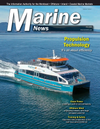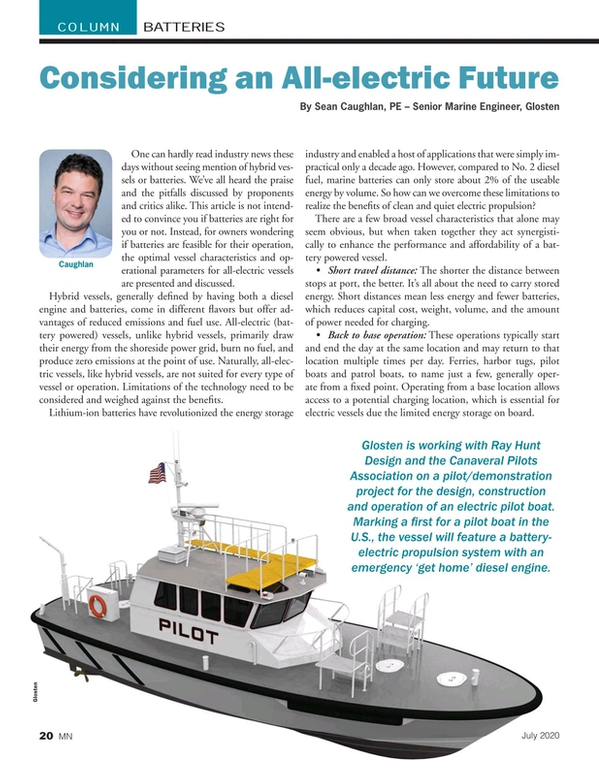
Considering an All-electric Future
One can hardly read industry news these days without seeing mention of hybrid vessels or batteries. We’ve all heard the praise and the pitfalls discussed by proponents and critics alike. This article is not intended to convince you if batteries are right for you or not. Instead, for owners wondering if batteries are feasible for their operation, the optimal vessel characteristics and operational parameters for all-electric vessels are presented and discussed.
Hybrid vessels, generally defined by having both a diesel engine and batteries, come in different flavors but offer advantages of reduced emissions and fuel use. All-electric (battery powered) vessels, unlike hybrid vessels, primarily draw their energy from the shoreside power grid, burn no fuel, and produce zero emissions at the point of use. Naturally, all-electric vessels, like hybrid vessels, are not suited for every type of vessel or operation. Limitations of the technology need to be considered and weighed against the benefits.
Lithium-ion batteries have revolutionized the energy storage industry and enabled a host of applications that were simply impractical only a decade ago. However, compared to No. 2 diesel fuel, marine batteries can only store about 2% of the useable energy by volume. So how can we overcome these limitations to realize the benefits of clean and quiet electric propulsion?
There are a few broad vessel characteristics that alone may seem obvious, but when taken together they act synergistically to enhance the performance and affordability of a battery powered vessel.
- Short travel distance: The shorter the distance between stops at port, the better. It’s all about the need to carry stored energy. Short distances mean less energy and fewer batteries, which reduces capital cost, weight, volume, and the amount of power needed for charging.
- Back to base operation: These operations typically start and end the day at the same location and may return to that location multiple times per day. Ferries, harbor tugs, pilot boats and patrol boats, to name just a few, generally operate from a fixed point. Operating from a base location allows access to a potential charging location, which is essential for electric vessels due the limited energy storage on board.
- Shore power: Typically, all-electric vessels will need to charge periodically throughout the day. For example, ferries operating on a fixed route may charge every one-way trip or every round trip to minimize the size of the battery bank. Shore power must be sized appropriately to recover the energy used in the available time at dock. For vessels with a high operational rate, the power levels can become very large, often in the megawatt range. High voltage shore power is sometimes necessary to keep cable sizes reasonable. Understanding shore power needs, availability, and limitations should be one of the first feasibility criterion to assess.
- Slower speeds: Speed is especially challenging for battery power. High speed means high propulsion power and low vessel weight. Since energy is power multiplied by time, high-speed vessels operating even on shorter routes can consume large amounts of energy. Slower vessels often have hull forms that are less weight and volume sensitive, meaning batteries and power electronics can be more easily accommodated.
- Operational frequency: Operational frequency should be carefully considered when evaluating the feasibility of an electric vessel. All things being equal, a vessel that operates less often will be easier to design or convert to all-electric. For example, a ferry operating 10 short round trips per day will have fewer challenges than one operating 20 or 30 round trips per day. Fewer trips mean more time to charge between trips, lower charging power, and simpler charging logistics. Furthermore, the lifetime of lithium-ion batteries is dependent on the number and depth of discharge cycles. Increasing battery life is typically accommodated by increasing the quantity of the batteries that are carried. It is not unusual for a battery to only be cycled to 30% of the nameplate capacity. This means you may be carrying three times more energy capacity than the vessel typically uses between charging cycles. The increased battery lifetime comes at the penalty of weight and capital cost.
On the other hand, energy from the electrical grid costs less than diesel fuel. The more energy that is consumed, the higher the potential savings and the shorter the payback time. Vessels that burn very little fuel could have long payback times, even if technical feasibility is established. While there are many good reasons for owners to consider an all-electric vessel, economics will often be one of the most important.
Before considering a new electric vessel project or a conversion, owners should carefully consider all these factors as part of establishing the technical feasibility for their operation. To start this process, it is important to gather as much information as possible about your vessels operational profile. The profile should establish propulsion and auxiliary power requirements over the vessel’s normal operation. Contact the utilities to discuss availability and costs for shore power. If the expertise doesn’t exist within your organization, discuss your operation with an experienced naval architect with knowledge of battery electric vessels.
The marine industry has always been understandably conservative about embracing new technology. While hybrid and battery powered vessels are emerging quickly, energy density (weight and size), cost, and cycle life will all need continuous improvement for the technology to become more widely adopted. With battery improvements and increasing pressure to reduce emissions, more owners will ask whether all-electric technology is right for their operation. Given the complexities of integrating emerging technologies and shoreside utilities on top of a typical vessel acquisition or conversion timeline, owners should consider their operations in light of these criteria to be prepared for their future.
Read Considering an All-electric Future in Pdf, Flash or Html5 edition of July 2020 Marine News
Other stories from July 2020 issue
Content
- Interview: Eddie Brown, Cummins' Director of Business Development, Marine page: 12
- Examining LNG as Fuel page: 16
- Considering an All-electric Future page: 20
- Maritime Training amid COVID-19 page: 26
- A Quiet Revolution page: 34
- Propulsion Profile: Konrad-driven page: 40
- The Advantages of Variable Speed Gensets page: 43
- Workboat Repower: New Life for Miss Vivian page: 46
- Torqeedo Drives Toward Marine Electromobility page: 52


